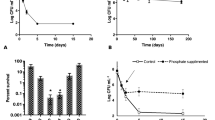Abstract
Comparative analysis of glucose fermentation in typical strains of V. cholerae biovar El Tor isolated in the Russian Federation in 1970–1990 and highly virulent strains of genovariants imported in 1993–2012 was carried out. It was demonstrated that glucose metabolism of V. cholerae biovar El Tor genovariants changed as a result of acquisition of classical CTX prophage (or only its ctxB gene) and a corresponding increase in virulence. A phenotypical manifestation of these changes is a lack of ability to grow on a minimal nutrient medium supplemented with 1% carbohydrate, as well as compromised capacity for acetoin fermentation in the course of the Voges–Proskauer test. Possible causes of the degraded glucose metabolism are associated with the presence of SNP in gene alsD that encodes acetolactate decarboxylase enzyme and is incorporated into als operon, which, in turn, is involved in acetoin generation, as well as with hyperexpression of regulatory protein AphA that controls acetoin biosynthesis.
Similar content being viewed by others
References
Kaper, J.B., Morris, J.G., and Levine, M.M., Cholera, Clin. Microbiol. Rev., 1995, vol. 8, pp. 48–86.
Nair, G.B., Faruque, S.M., Bhuiyan, N.A., Kamruzzaman, M., Siddique, A.K., and Sack, D.A., New variants of Vibrio cholerae O1 biotype EL Tor with attributes of the classical biotype from hospitalized patients with acute diarrhea in Bangladesh, J. Clin. Microbiol., 2002, vol. 40, pp. 3296–3299. doi 10.1128/JCM.40.9.3296-3299.2002
Smirnova, N.I., Zadnova, S.P., Shashkova, A.V., and Kutyrev, V.V., Genome variability in the altered variants of Vibrio cholerae biovar El Tor isolated in Russia, Mol. Genet., Microbiol. Virol., 2011, vol. 26, no. 3, pp. 102–110.
Matson, J.S., Withey, J.H., and DiRita, V.J., Regulatory networks controlling Vibrio cholerae virulence gene expression, Infect. Immun., 2007, vol. 75, pp. 5542–5549. doi 10.1128/IAI.01094-07
Faruque, S.M. and Nair, G.B., Vibrio cholerae Genomics and Molecular Biology, Norfolk: Caister Academic Press, 2008.
Kuhn, J., Finger, F., Bertuzzo, E., Borgeaud, S., Gatto, M., Rinaldo, A., et al., Glucose-but not ricebased oral rehydration therapy enhances the production of virulence determinants in the human pathogen Vibrio cholerae, PLoS Neglected Trop. Dis., 2014, vol. 8, no. 12, p. e3347. doi 10.1371/journal.pntd.0003347
Callahan, L.T. and Richardson, S.H., Biochemistry of Vibrio cholerae virulence III. Nutritional requirements for toxin production and the effects of pH on toxin elaboration in chemically defined media, Infect. Immun., 1973, vol. 7, pp. 567–572.
Yoon, S.S. and Mekalanos, J.J., 2,3-Butanediol synthesis and emergence of the Vibrio cholerae El Tor biotype, Infect. Immun., 2006, vol. 74, pp. 6547–6556.
Kovacikova, G., Lin, W., and Skorupski, K., Dual regulation of genes involved in acetoin biosynthesis and motility/biofilm formation by the virulence activator AphA and the acetate-responsive LysR-type regulator AlsR in Vibrio cholerae, Mol. Microbiol., 2005, vol. 57, pp. 420–433. doi 10.1111/j.1365-2958.2005.04700.x
Iwanaga, M. and Yamamoto, K., New medium for the production of cholera toxin by Vibrio cholerae O1 biotype El Tor, J. Clin. Microbiol., 1985, vol. 22, pp. 405–408.
Svennerholm, A.M. and Wiklund, O., Rapid GM1-enzyme-linked immunosorbent assay with visual reading for identification of Escherichia coli heat-labile enterotoxin, J. Clin. Microbiol., 1983, vol. 17, pp. 596–600.
Livak, K.J. and Schmittgen, T.D., Analysis of relative gene expression data using real-time quantitative PCR and the 2-ΔΔCT Method, Methods, 2001, vol. 25, pp. 402–408. doi 10.1006/meth.2001.1262
Guarino, A., Albano, R., and Guandalini, S., Oral rehydration: Toward a real solution, J. Pediatr. Gastroenterol. Nutr., 2001, vol. 33, pp. S2–S12.
Oh, Y.T., Lee, K.-M., Barl, W., Raskin, D.M., and Yoon, S.S., (p)ppGpp, a small nucleotide regulator, directs the metabolic fate of glucose in Vibrio cholerae, J. Biol. Chem., 2015, vol. 290, pp. 13178–13190. doi 10.1074/jbc.M115.640466
WHO. New formula oral rehydration salts, WHO Drug Inf., 2002, vol. 16, pp. 113–203.
Dutta, D., Bhattacharya, M.K., Deb, A.K., Sarkar, D., Chatterjee, A., Biswas, A.B., et al., Evaluation of oral hypo-osmolar glucose-based and rice-based oral rehydration solutions in the treatment of cholera in children, Acta Paediatr., 2000, vol. 89, pp. 787–790. doi 10.1111/j.1651-2227.2000.tb00386.x
Son, M.S., Megli, C.J., Kovacikova, G., Qadri, E., and Taylor, R.K., Characterization of Vibrio cholerae O1 El Tor biotype variant clinical isolates from Bangladesh and Haiti, including a molecular genetic analysis of virulence genes, J. Clin. Microbiol., 2011, vol. 49, pp. 3739–3749. doi 10.1128/JCM.01286-11
Safa, A., Nair, G.B., and Kong, R.Y., Evolution of new variants of Vibrio cholerae O1, Trends Microbiol., 2010, vol. 18, no. 1, pp. 46–54. doi 10.1016/j.tim.2009.10.003
Ghosh-Banerjee, J., Senoh, M., Takahashi, T., Hamabata, T., Barman, S., Koley, H., et al., Cholera toxin production by the El Tor variant of Vibrio cholerae O1 compared to prototype El Tor and Classical biotypes, J. Clin. Microbiol., 2010, vol. 48, pp. 4283–4286.
Zadnova, S.P., Shashkova, A.V., Krasnov, Ya.M., and Smirnova N.I., Phenotypic and genetic analysis for changed variants of Vibrio cholerae biovar El Tor, Probl. Osobo Opasnykh Infekts., 2012, vol. 1, no. 111, pp. 57–61.
Author information
Authors and Affiliations
Corresponding author
Additional information
Original Russian Text © S.P. Zadnova, N.B. Cheldyshova, A.A. Kritskii, A.K. Adamov, Z.L. Devdariani, V.V. Kutyrev, 2017, published in Molekulyarnaya Genetika, Mikrobiologiya i Virusologiya, 2017, No. 2, pp. 64–69.
About this article
Cite this article
Zadnova, S.P., Cheldyshova, N.B., Kritskii, A.A. et al. Comparative analysis of glucose metabolism in strains of Vibrio cholera biovar El Tor. Mol. Genet. Microbiol. Virol. 32, 94–99 (2017). https://doi.org/10.3103/S0891416817020112
Received:
Published:
Issue Date:
DOI: https://doi.org/10.3103/S0891416817020112




